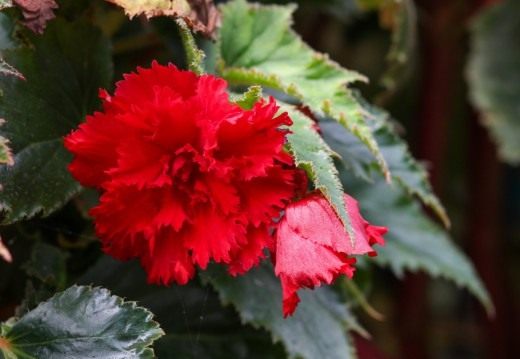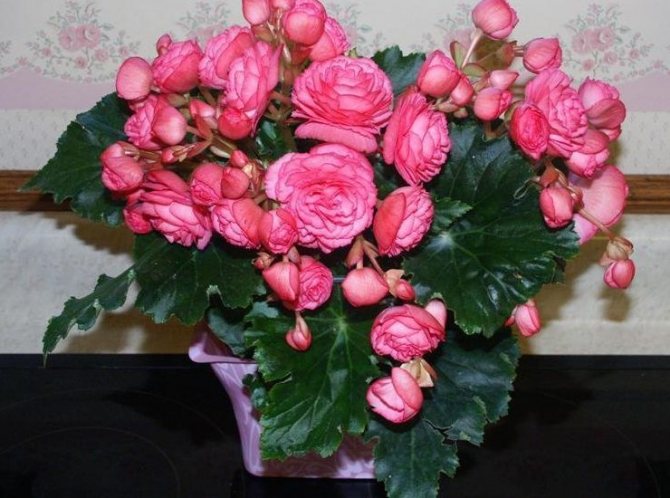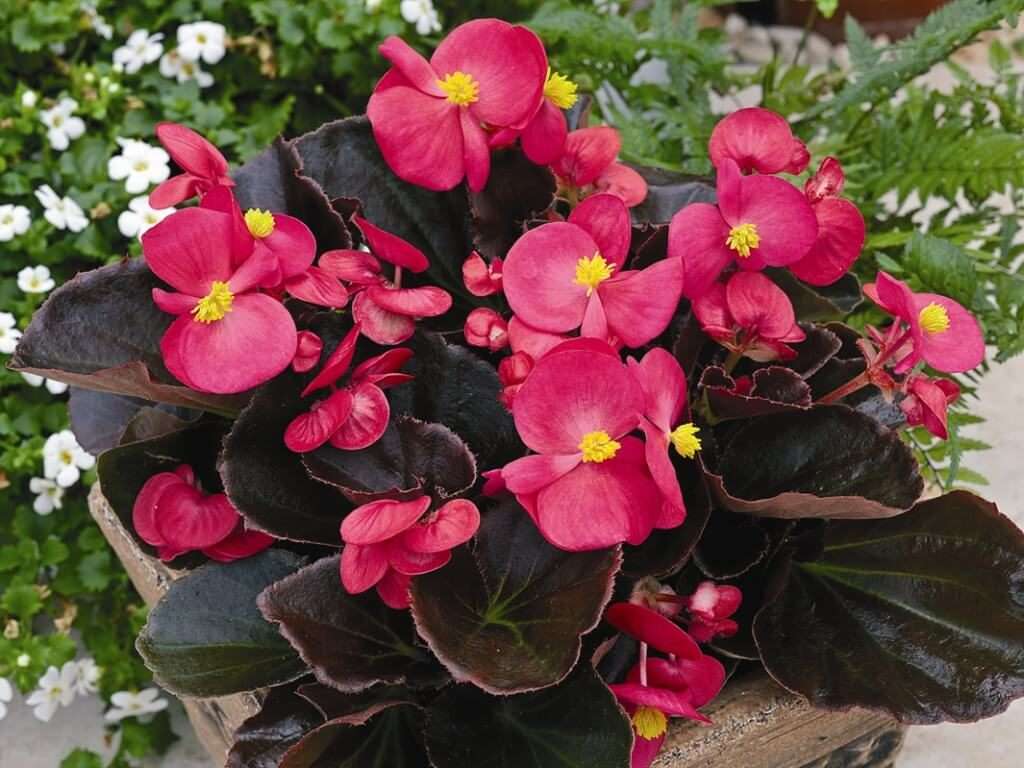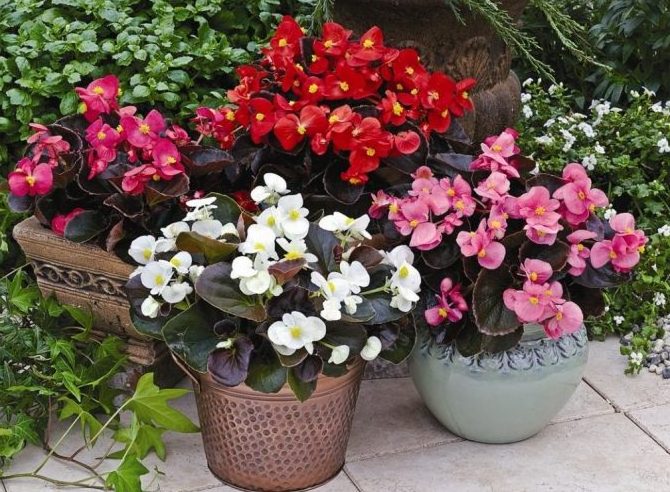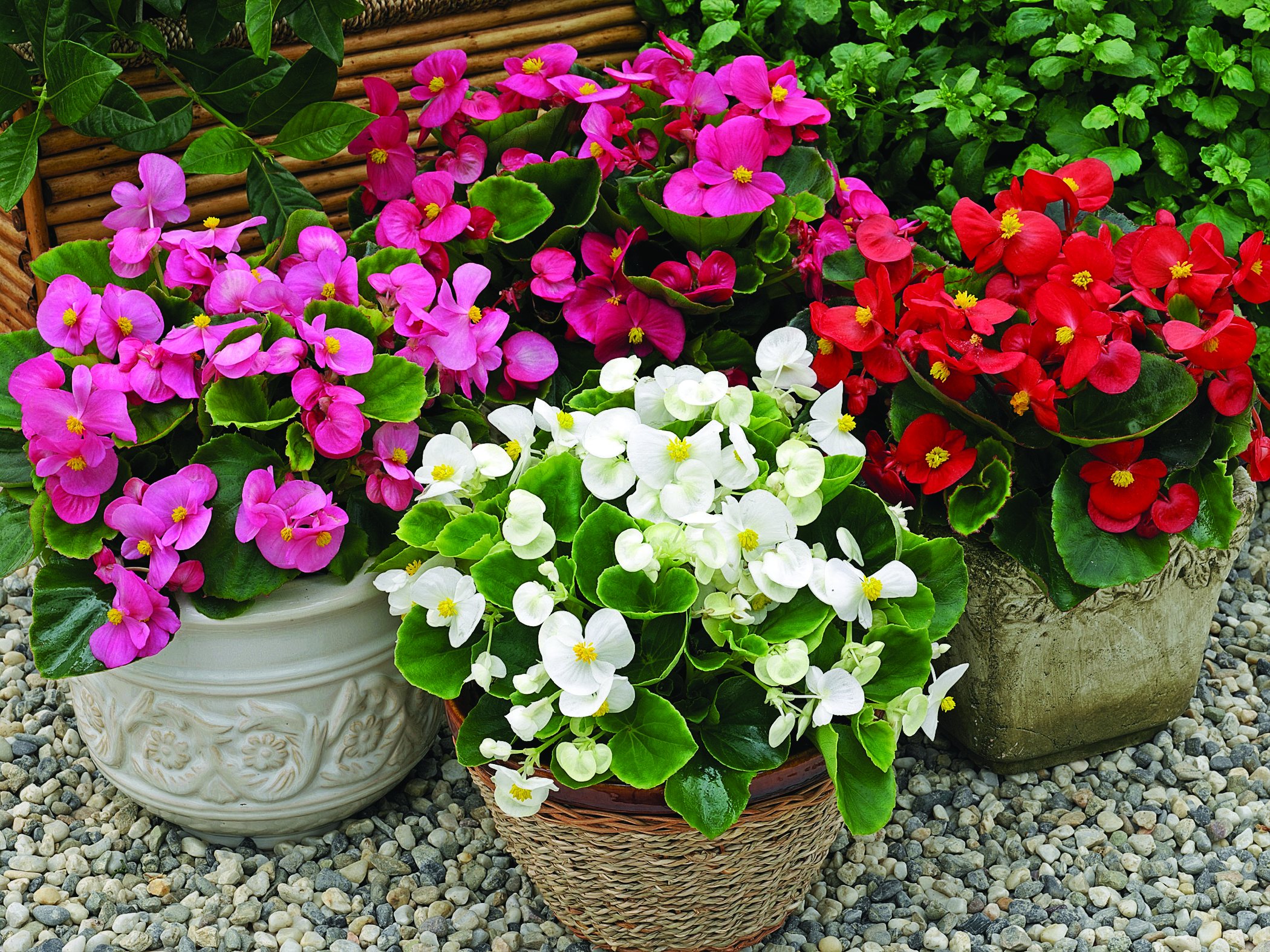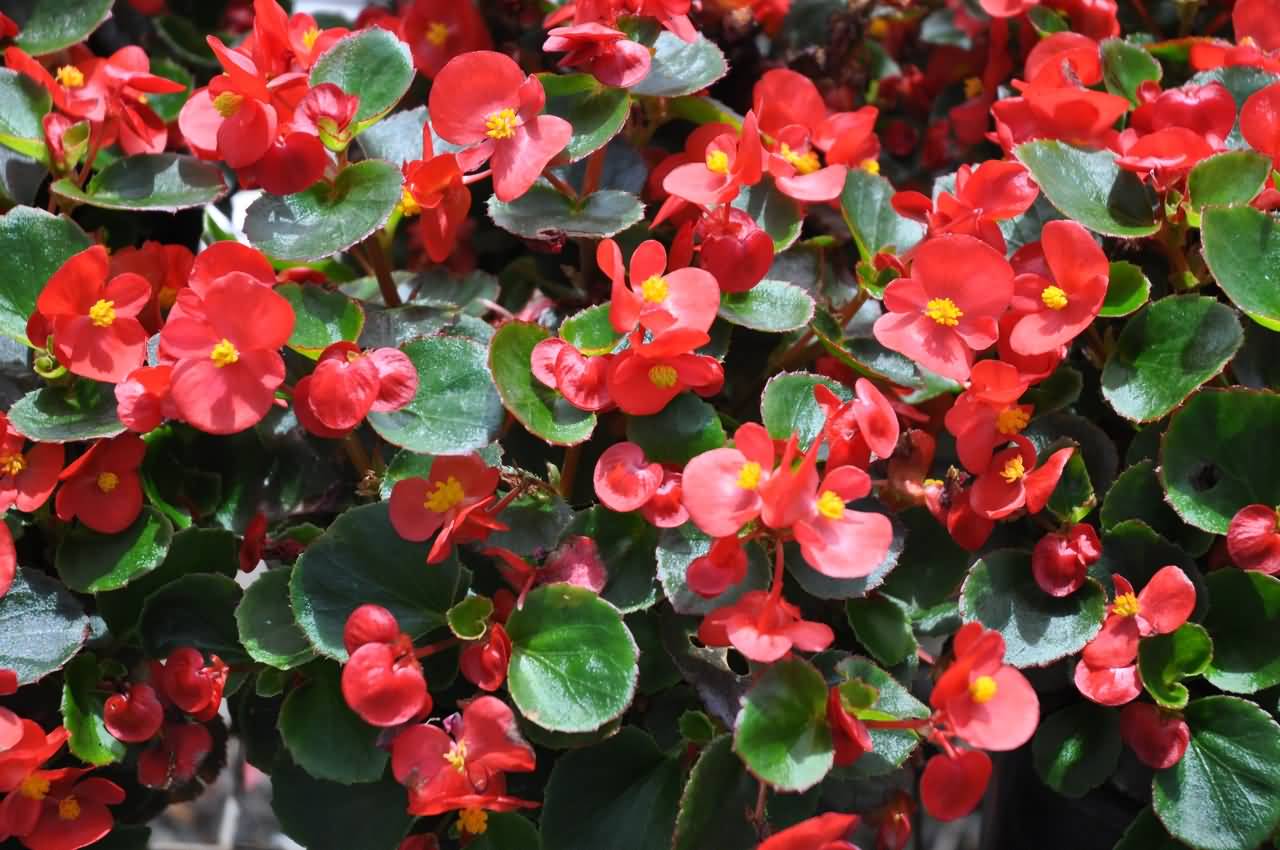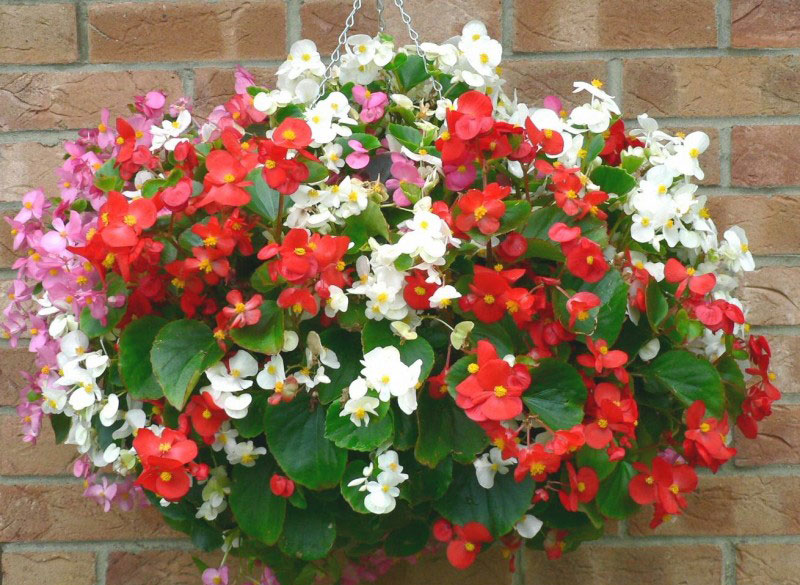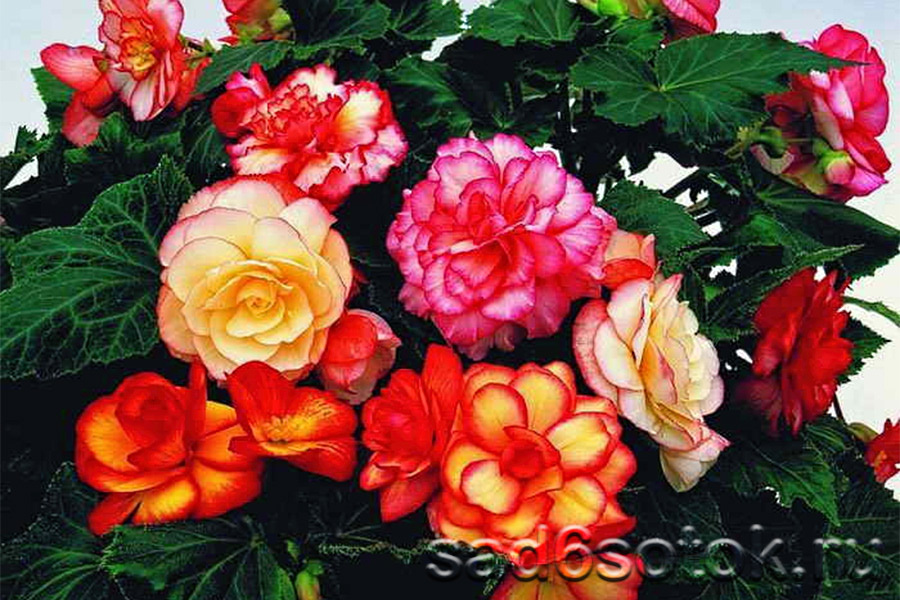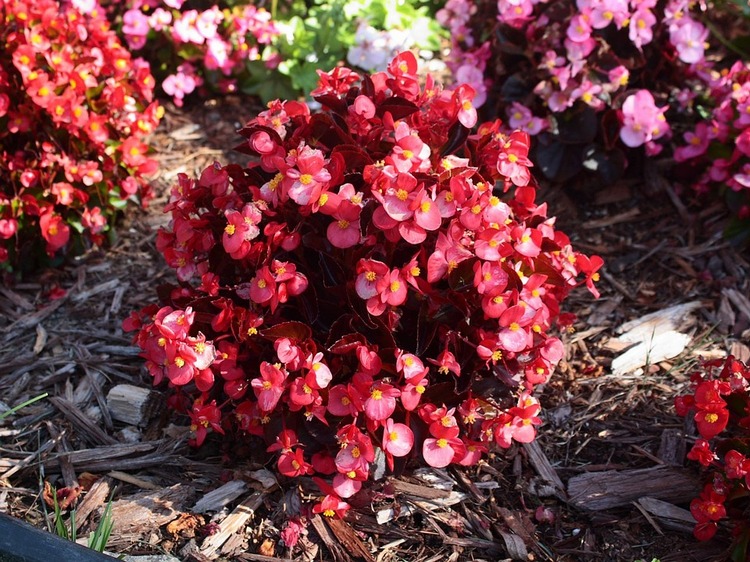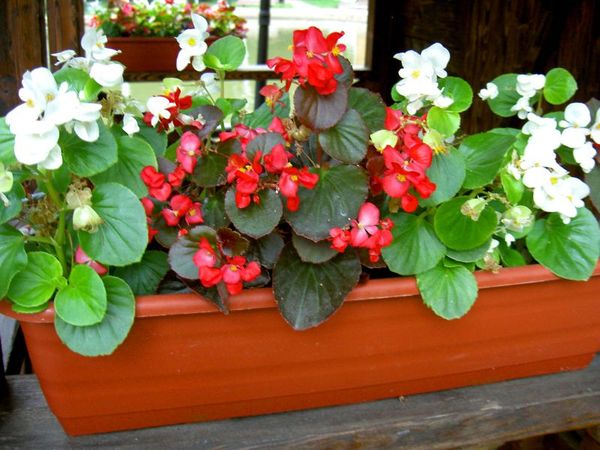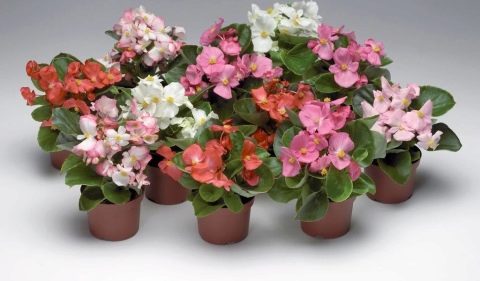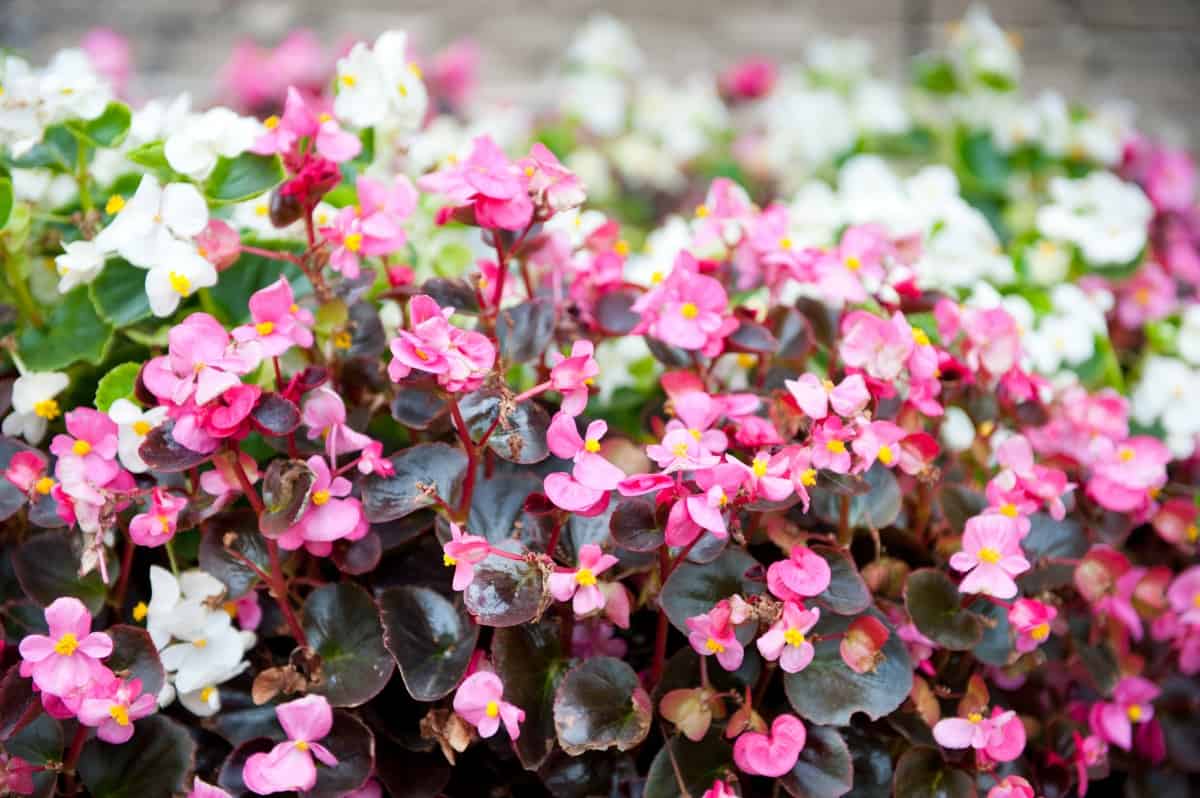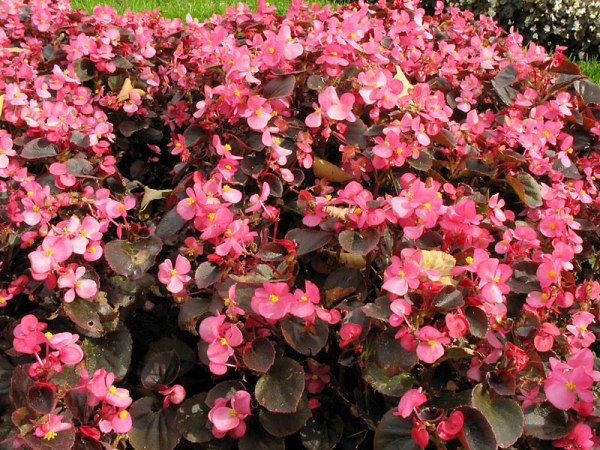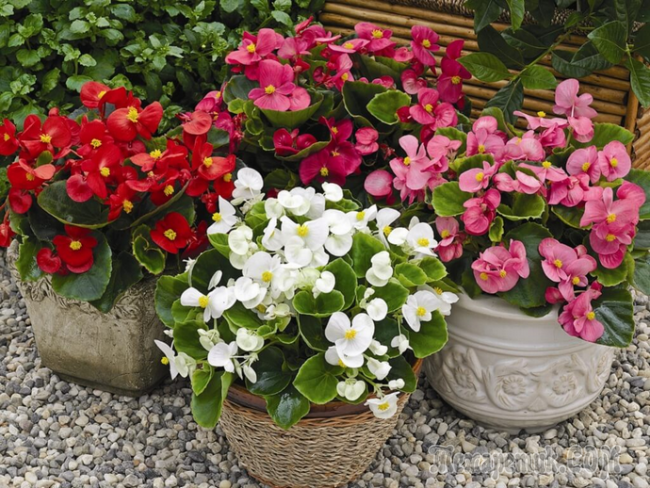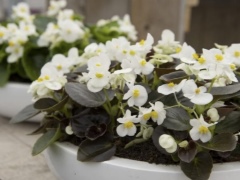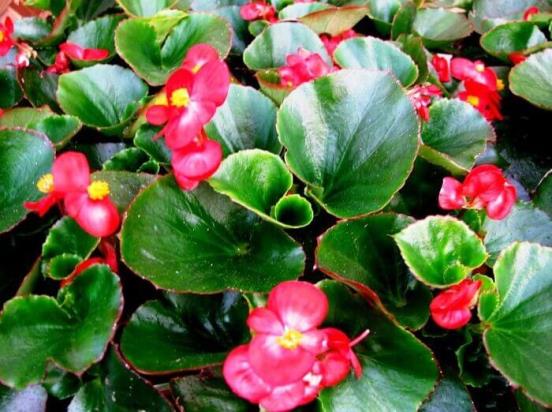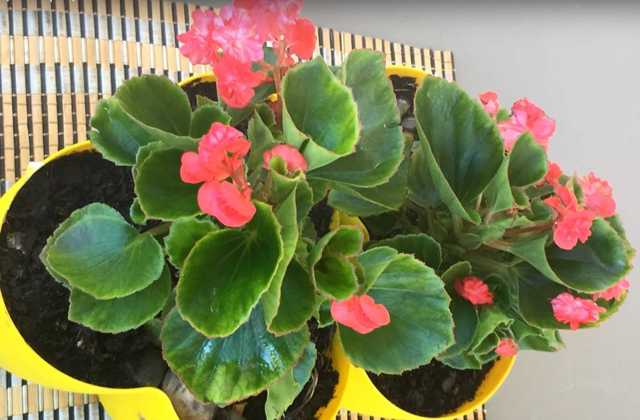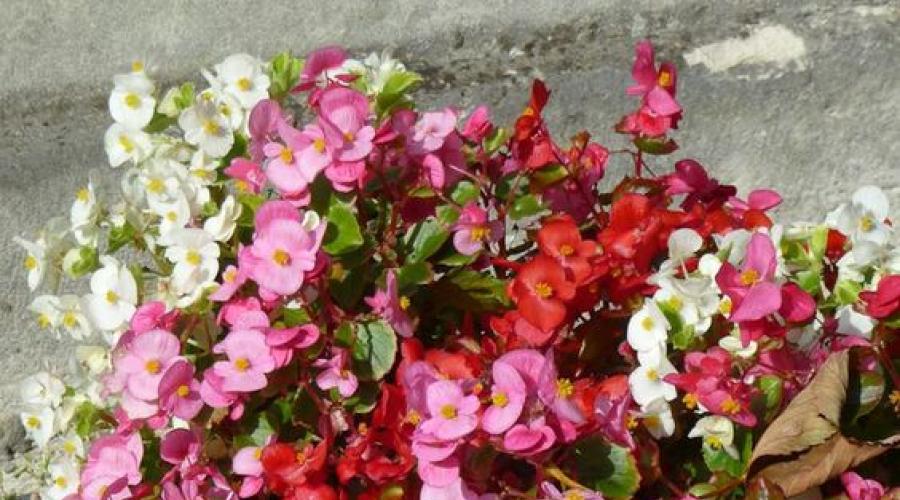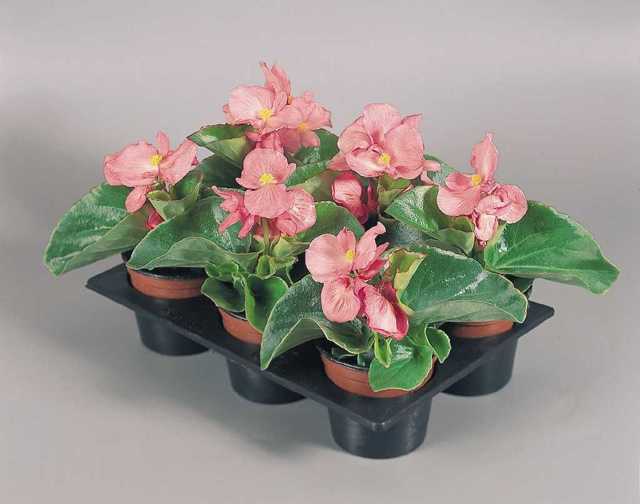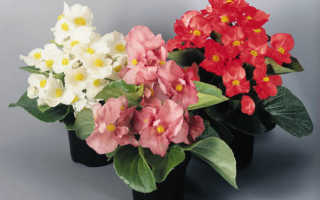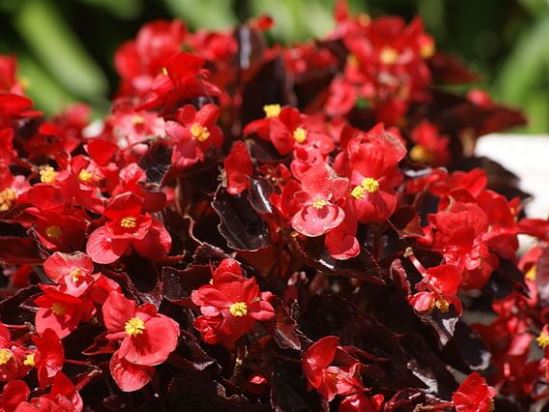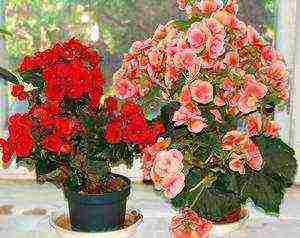Care
Pot
Choose a pot for planting that is shallow, but wide (3-4 cm wider than the previous one). Planting is carried out in the spring - at this time the begonia will take root better. Give preference to a clay pot: the plastic one heats up very much, the gypsum and glass do not let the air through properly. Clay, on the other hand, provides good air circulation and does not retain moisture.
Location and lighting
Tuberous begonia grows equally well both in a well-lit place and in partial shade. However, avoid extremes! Penumbra does not mean the darkest corner in the apartment, and the illuminated area is not equal to the sun. An east window works well, but keep the flower free from drafts.
Watering and humidity
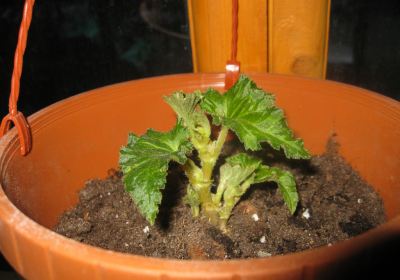 Watering should be sufficient and frequent, but in moderation: do not allow swamps to form in the pot! In between procedures, the soil should dry 1-1.5 cm.
Watering should be sufficient and frequent, but in moderation: do not allow swamps to form in the pot! In between procedures, the soil should dry 1-1.5 cm.
Cold water is dangerous - the delicate roots rot from it. Therefore, be sure to pre-settle the liquid to remove chlorine and harmful substances, and warm it to room temperature. Tuberous begonia should be watered in the morning.
The humidity in the room should be slightly increased, but often you do not need to spray the plant - droplets of moisture can leave an unpleasant-looking stain on the leaves. Find another way to humidify the air: you can, for example, put a saucer of damp moss near the pot and pour water into it from time to time, or buy a household air humidifier.
Temperature
Instances growing in the house require a temperature in the range of +18 - +23 degrees during the active growing season, and not lower than +15 in winter.
Top dressing
With regards to feeding: everything is simple. Once before flowering (this is especially recommended for early planting), apply fertilizer with a high nitrogen content - it will slow down flowering and instruct the leaves to grow more actively. The rest of the time - with the beginning of flowering - 2 times a month, feed with any complex for flowering plants.
Transfer
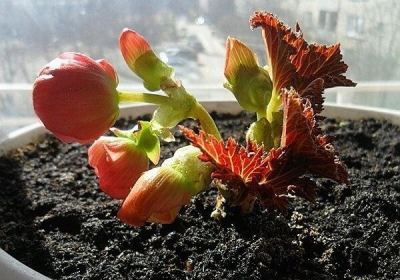 Transplant in the spring, before the shoots appear.
Transplant in the spring, before the shoots appear.
Remove the tuber from the pot, inspect for damage (cut off the rotten and dried roots with a disinfected blade, like the areas on the tuber), hold it in a pale pink solution of potassium permanganate for half an hour and plant it in a new pot with fresh soil.
Remember: the tuber cannot be completely covered, but just sprinkle the roots on top a little.
Priming
Begonia has no special soil requirements. Buy a multipurpose mixture at a gardening store, or mix equal parts sand, peat, humus, and leafy soil. Do not forget to ignite the mixture in the oven before planting (30 minutes at 90 degrees). Drainage - broken brick or expanded clay.
How to keep in winter?
The dormant period in tuberous begonia begins in November and lasts until the end of February. Shoots die off, leaves fall off - a sight, in general, unpleasant. But there is still one "plus" - the tuber remains, and if you save it, your flower will soon return to you.
 Peel off the ground from the tuber, cut the roots, place in a cool (not higher than +15 degrees) and dry place. However, the tuber can be left in a pot and rearranged directly in the container to a dry, cool corner. Watering at this time is minimal: 2 times are enough.
Peel off the ground from the tuber, cut the roots, place in a cool (not higher than +15 degrees) and dry place. However, the tuber can be left in a pot and rearranged directly in the container to a dry, cool corner. Watering at this time is minimal: 2 times are enough.
It is better not to leave begonia growing in the garden in the ground. As soon as the leaves and shoots die off, dig up and place them for the winter until February.
How to store first year begonia tubers?
Begonia tubers grown from seeds this year do not sleep during the winter. In the first year of its life, the plant tries to increase the mass of the tuber, and therefore retains the leaves.If the seedlings developed in open ground, then before the onset of the first night frosts, the plants must be transplanted into pots and swept into the house.
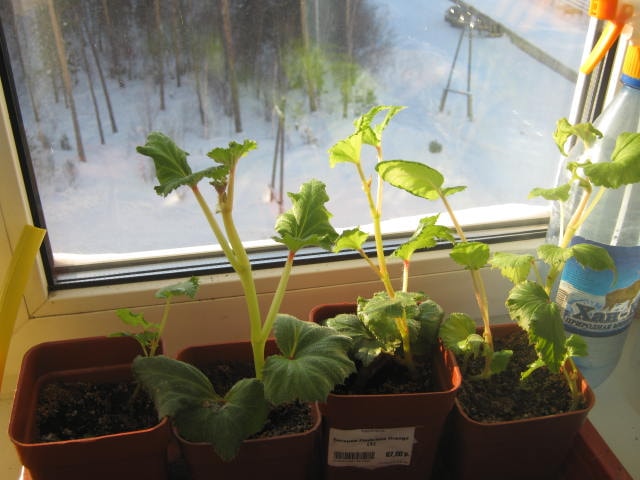
How to store first-year tubers in winter? They do not shed their leaves and are not laid to rest. They should wait out the winter in a cool and bright place, where the temperature does not drop below + 15 degrees. How experienced florists do:
- They stop feeding since September.
- The buds that the plant lays in September-October must be cut off.
- It is necessary to water the first-year begonia tuber as the top layer of the soil dries up. Watering is carried out along the contour of the pot. Water should not come into contact with the tuber. The optimal watering regime is once a week. It is possible less often if the temperature of the content is within +15 degrees.
- Lighting is required. Otherwise, the stems of the begonia will simply stretch out.
- You can store begonias in winter on the east side of the house. But heating devices in this case can dry the air and raise the ambient temperature, and therefore a container with water can be placed on the windowsill.
- You cannot feed the flower. Although it retained the ground part, it practically does not consume nutrients from the soil, and their excess can lead to root rot.
In spring, extended cuttings can be cut and rooted, but only after the tuber has given new stems.
Transfer
Home begonia transplant is carried out annually. This is a simple procedure that does not require any special skills. It is enough to choose a soil and plant a flower in a pot. The transplanting process is carried out in early spring and no later than May, when the flower begins to emerge from the winter dormancy stage. If the transplant is not carried out at all or is carried out less often, then the flower will lose its decorative appearance.
Pots and soil
For planting begonias, a small pot with a diameter of 3 to 4 cm larger than the size of the root system is suitable. A more spacious pot should be taken to rhizome types of culture, which cannot be said about tuberous representatives. For them, this shape of the container will lead to waterlogging of the soil and later flowering.
When choosing a plastic pot, expanded clay should be put on its bottom. It will absorb moisture and prevent stagnant water. The ceramic pot is breathable and absorbs moisture well. The root system of begonia in such a container will develop well and will grow to the walls over time. When transplanting the plant, the roots will be damaged, as they will have to be torn off the walls.

The soil for the culture is taken loose, light and fertile, consisting of 2/3 leaf land and one part of sand, black soil and peat. Ready-made soil mixture can be purchased at a flower shop or you can make it yourself. The acidity level of the soil should be in the range of 5.5─6.5 rN.
Transfer
It is better to transplant begonias when the need is ripe for this:
-
the flower has grown greatly;
-
there was a need for reproduction;
-
in case of loss of decorativeness;
-
after shopping at the store.
Rhizome varieties of begonias should be transplanted as the plant grows. Do not transplant the plant on dry soil or immediately after watering. A good time to transplant begonias is the day after the soil is moistened.
Transfer instructions after purchase (transfer method):
-
remove the flower from the pot and clean the roots from the earth;
-
remove rotten, tangled or damaged roots;
-
cut the root sites with crushed charcoal;
-
place the entire root system of begonia in a weak solution of potassium permanganate for 30 minutes;
-
put drainage material in the pot on the bottom, on top - a layer of charcoal and soil mixture;
-
place the plant in a new pot with prepared soil, sprinkle with soil to the top of the horse system and compact;
-
water well.
Over the course of a week, the soil will settle, its top layer will dry out, and then you can add some more earth to the pot.Young plants easily tolerate transplantation, adult specimens experience stress from this procedure
The first month, until the culture takes root, due attention should be paid to begonias, creating the necessary conditions for its growth.
Tuberous species are not recommended to be immediately planted in the ground, they must be germinated. To do this, the planting material must be placed in a box on the soil mixture without deepening and removed to a cool, well-lit and humid place. The bulbs are then ready for planting.

Various shapes and types
Begonia comes in all shapes, sizes and colors. It can be a herbaceous plant and a rather large shrub. There is a stemless species with only one leaf. The color of the leaves ranges from light green to dark green. On the reverse side, they are covered with various spots and patterns. Begonia flowers come in different colors, both bright and pale. There are plants with summer and winter flowering. We present you the most popular types of home begonias:
- Eternal blooming. A popular type of bushy group. It is not for nothing that it is so named, because it can bloom in a pot throughout the year. Differs in small flowers of white, pink, red color. The leaves of a deep green color give off a gloss.
- Ampelnaya. It is used for vertical outdoor gardening in flowerpots or on window sills. Its shoots resemble colorful garlands hanging up to 50 cm in length. On the stems of the plant there can be yellow, orange, white, pink buds. Flowering extends throughout the growing season.
- Royal. Has truly imperial grandeur. It is characterized by large dark green leaves up to 30 cm long. The leaflets are also unusual, they resemble the heart or shell of a snail.
- Tuberous. It is considered a real decoration of the windowsill. Its buds are very large: they can reach 15 cm in size. The shape of the inflorescence is similar to a peony. There are classic and double flowers. The colors can be orange, white, pink, red. The petals are monochromatic, two-colored or with an original border.
- Begonia Elatior. Refers to a tuberous hybrid that is grown at home. A plant with powerful reddish stems that need support. Flowering occurs in autumn and winter. Its white, yellow, orange or red inflorescences can be up to 5 cm in diameter. It is characterized by glossy round leaves.
How to propagate at home?
For home breeding, the vegetative method is most often used.
Cuttings
In winter, the ever-flowering begonia, due to a lack of light, sheds part of the leaves and stretches out a little, so a strong pruning is inevitable. The remains of cut young stems are put on cuttings. Young shoots are cut with a sharp knife so as not to damage the plant itself and leave a clear cut on the stem.
Preparing cuttings
The optimum branch length is 10 cm. There should be 2-3 buds on the cut stem. If the leaves are too large or there are too many of them, it is worth pinching them so that they do not take up all the nutrients.
The cutting itself must be left to dry for several hours. When the juice stops flowing from the cut, you can start rooting.
Rooting
A begonia stalk is half water, so it is better to root it directly into the ground to avoid rotting of the shoot. The stalk is buried vertically into the prepared soil to a depth of 1-2 cm and sprinkled with sand.
To create a favorable atmosphere for growth, the container with the flower is placed in a warm and well-lit place and sufficient watering and spraying is provided. At the first time after planting, the stalk can be additionally covered with a cut plastic bottle, simulating the greenhouse effect.
Ever-flowering begonia quickly grows roots, so no pretreatment with root stimulants is required.
Planting in soil
Before planting, begonia is hardened on the balcony for several weeks. Planting is carried out in late May-early June at the permanent place of growth of the plant.
- The seedlings and the hole are pre-moistened.
- If the seedlings are overgrown or elongated, the long shoots must be shortened.
- The flower is laid in a hole with a preserved lump of earth 1-2 cm below the growth level of the seedlings, the soil around the stem is compacted.
- The distance of one flower from another when planting should be at least 10 cm.
Important! A well-lit area is suitable for the landing site; the soil is slightly acidic, rich in organic fertilizers, but not too wet.
We suggest you watch a video about propagation by cuttings:
- Begonia seeds are very small, dusty, dark brown in color, therefore, for ease of planting, it is recommended to mix them with sand.
- Seeds are preferably sown in a greenhouse or in boxes in January-February.
- A soft soil mixture with a large proportion of peat is used as a soil.
- The seeds are placed on moist soil, pressed into the soil and covered with a small layer of calcined sand.
- The container is covered with glass or transparent film and systematically ventilated.
- The first shoots should appear in 10-12 days.
Caring for Tuberous Begonia at home
In order for a plant to delight with its unusually beautiful flowers, it needs to create favorable conditions.
Indoor air temperature
The temperature regime largely depends on the plant species. For specimens blooming in winter, it is necessary to ensure the temperature is within + 13 ° С ... + 21 ° С
If the tubers of Begonia in winter are in a state of complete dormancy, and its stems die off, then during this period it is very important to protect the flower from frost
Air humidity
Tuberous begonia adapts to different levels of humidity in the room, but it feels more comfortable with high humidity. In this case, the ingress of water droplets on the leaf plates during spraying can harm them. With this in mind, it is better to choose a different method of humidifying the air in the room.
Watering
Watering Tuberous Begonia is necessary after the substrate dries out by about 1-1.5 cm. Watering should be abundant. This is especially true during the dry season. However, in no case should waterlogging of the soil mixture, stagnation of water in the pot, be allowed, since all this will lead to rotting of the tuber.
Water for irrigation is used at room temperature. Watering with cold water is strictly prohibited!
For species that are dormant in winter, the amount of watering is reduced. This should be started only after the leaves begin to turn yellow and fly around.
Location. Lighting
As noted above, Tuberous begonia can grow in the shade, however, as for most plants, it likes a bright place, but only protected from direct sunlight. The best place in the room is the window sills of the windows of the western or eastern orientation. Species that bloom in winter require a lot of light, especially during the period when buds are forming and flowering begins.
In the warm season, the pot with Begonia can be taken out into the fresh air, installed in a place protected from cold drafts, preferably in partial shade.
Fertilization
Experts recommend starting to feed Tuberous Begonia with the onset of flowering. To do this, twice a month, the bush is fed with complex fertilizers for flowering plants.
Flowering period
During flowering, the large-flowered Tuberous Begonia needs special care. Small female flowers growing next to large male flowers must be cut out. Any wilted flowers should also be removed. This procedure may not be carried out only if a species with small flowers is grown.
Tuberous begonia in winter
As a rule, most species of Tuberous Begonia enter a dormant period. It starts in November and ends in February. At this time, the shoots of the plant begin to die off, the leaves turn yellow and fall off. As a result, the pot becomes empty, it contains only the tuber. How do I save it? There are two ways.
The first way. The tuber is removed from the soil, cleaned of it, the roots are trimmed, after which the tuber is placed in a cool dry place with an air temperature of at least + 15 ° C. From mid-January, the tuber can be planted again in fresh soil.
Second way. It is simpler. The tuber is not removed from the pot, but remains in it. The pot is simply transferred to a cool room with an air temperature of + 15 ° C ... + 18 ° C. Watering is minimal - about 2 times during the entire dormant period.
Tuberous ampelous begonia
Peculiarities
Tuberous begonia is the result of a selection in which at least 8-9 plants were involved, previously grown in various areas around the world. Specialists began breeding work back in the 19th century, and today the results of such painstaking work are very impressive - more than 200 varieties of this perennial were born. Tuberous begonia differs from conventional cousins in that this plant can be both indoor and garden. There are ampelous, herbaceous and shrub varieties of this flower. However, the most important distinguishing feature is the presence of a developed root, which is formed in the form of a massive tuber, reaching up to 6-7 centimeters in diameter.
All tuberous begonias differ from their counterparts, while they are good in that they have a very abundant and long flowering. The shape of the flower is varied, it depends on the type of plant and outwardly it is similar in structure to a peony, daffodil, carnation or camellia. In addition, ampelous begonias have male and female flowers - male flowers are usually larger and more attractive in appearance, in contrast to female flowers. Flower sizes in hybrid varietal begonias vary from 3-3.5 to 18-20 centimeters. There are varieties where flowers are collected in inflorescences - such properties are most often possessed by ampelous varieties of begonias. The flowering period in hybrid begonias depends on the degree of formation of the plant - it begins in early May and lasts until the end of September - early October.
Begonia grown from a tuber does not tolerate low temperature conditions, therefore, it can be planted in open ground only at positive temperatures in late spring or even at the beginning of the summer period. It is noticed that with a group planting, plants move into growth more actively than with a single planting. If you decide to grow begonias at home, then low temperatures are not terrible for your perennials, and the green foliage that appears will actively purify the air and heal it.
In the phase of active flowering, tuberous begonias do not like permutations - this applies to the case when you grow a perennial at home. The flowering bush should not be rearranged or turned on its other side to the light source. In this regard, begonia is quite capricious - when changing its location, it can quickly shed its flowers. It is noteworthy that under unfavorable conditions, ampelous begonias usually shed the most beautiful male flowers, while female ones can hold out for a longer time.
Signs of trouble
The leaves turn pale, the shoots stretch out - the result of insufficient light, especially in winter. It is necessary to provide an optimal light regime, to organize supplementary lighting during a short daylight hours.
The intensity of flowering decreases - an excess of bright light and excessive humidity in the air. The plant needs shading and ventilation.
The edges of the leaves turn brown and dry - dry air and overheating.Limit exposure to direct sunlight and provide humidification.
Buds fall, flower buds dry - low air humidity. It is necessary to additionally moisten it.
Begonia sheds flowers - this happens with a sharp change in temperature and humidity; can be observed in a recently acquired or suddenly displaced specimen - as a stress reaction that passes as it adapts to new conditions, if they meet the needs of the plant.
Leaves and stems turn black - usually in frozen specimens that are grown outdoors. They choose intact, strong bushes, transplant them into pots and transfer them to a warm room.
Diseases and pests
When growing begonias, flower growers most often face the following problems:
- ticks;
- fungal infections;
- powdery mildew.
Before planting begonias in the soil, it is necessary to check the seeds for mites, which are carriers of various infections. To combat ticks, chemicals are most often used, such as "Anti-tick" or "Fufanon". Alternatively, you can use soap solutions chamomile or tobacco, which are applied to the lower part of the plant. Spraying should be continued until the complete disappearance of the parasites.
Begonias are also susceptible to fungal diseases. In such cases, you should treat the soil with special products sold in hardware stores. However, the greatest danger to begonias is powdery mildew, which appears on the plant in the form of plaque. This disease can be caused by too high humidity. The use of fungicides helps to say goodbye to powdery mildew.


